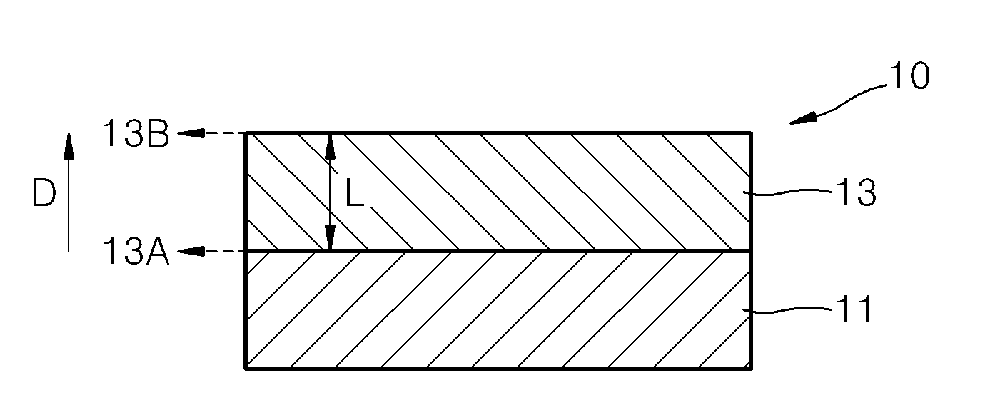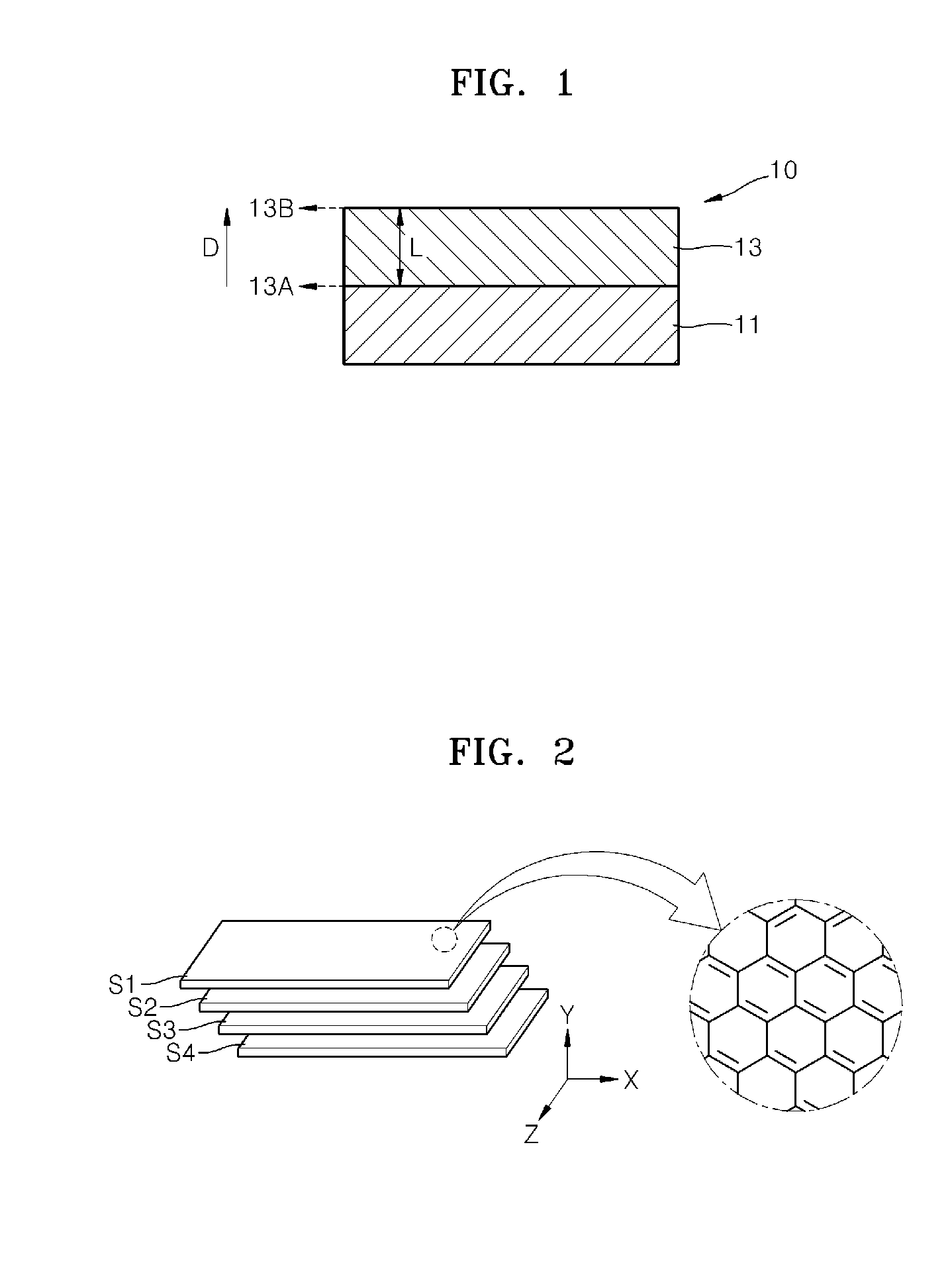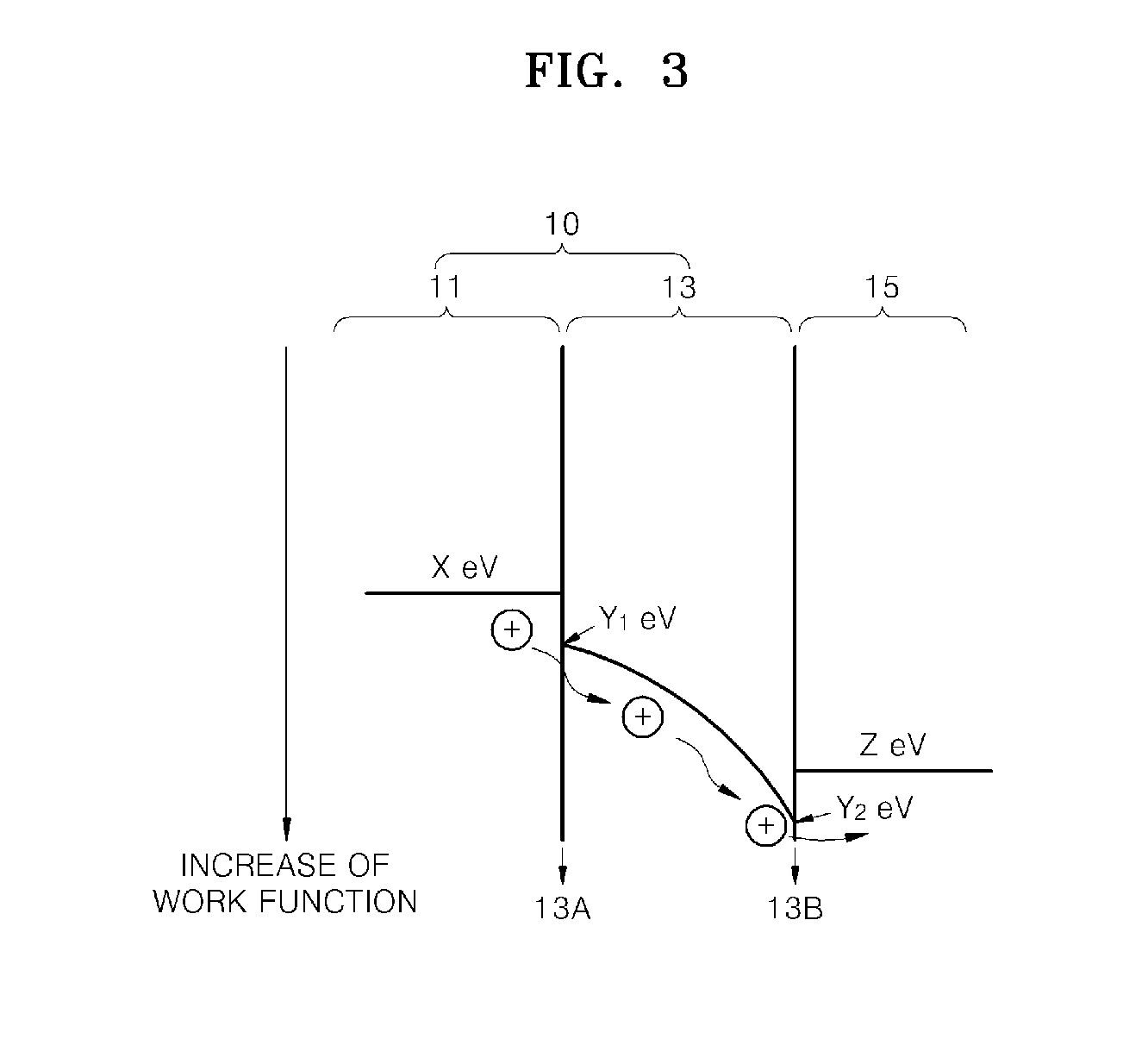Electrode and electronic device comprising the same
a technology of electronic devices and electrodes, applied in the field of electrodes and electronic devices, can solve the problems of insatiable mechanical strength, work function, conductivity, and light transmittance of conventional electrodes, and achieve the effect of excellent conductivity and high work function
- Summary
- Abstract
- Description
- Claims
- Application Information
AI Technical Summary
Benefits of technology
Problems solved by technology
Method used
Image
Examples
example 1
Preparation of Graphene-Containing Layer
[0183]A graphene-containing layer was formed on a poly(ethylene terephthalate) (PET) substrate according to the following method.
[0184]Formation and Transfer of Monolayer Graphene
[0185]A Cu-foil having a size of 9 cm×15 cm was installed in a tubular furnace, heated to 1000° C. at 90 mtorr while supplying H2 (8 s.c.c.m), and maintained at the same temperature for 30 minutes to form copper grains on the Cu-foil. Then, CH4 (24 s.c.c.m) and H2 (8 s.c.c.m) were supplied thereto at 460 mtorr for 30 minutes, and the Cu-foil was cooled to room temperature while supplying H2 at 90 mtorr to form a monolayer graphene on the Cu-foil.
[0186]Then, polymethacrylate (PMMA) was pressurized onto the monolayer graphene to contact the PMMA with the monolayer graphene. A Cu-foil / monolayer graphene / PMMA film was immersed in a 98% ammonium persulfate solution, as an etchant of copper for 300 to 360 minutes and washed with deionized water to remove the Cu-foil, so tha...
example 2
Preparation of Anode
[0195]A G2-HNO3, G3-HNO3, G4-HNO3, and G4-AuCl3, as graphene-containing layers, were respectively formed on the PET substrate in the same manner as in Example 1.
[0196]Then, a poly(3,4-ethylenedioxythiophene):poly(styrenesulfonate)(PEDOT:PSS) aqueous solution (CLEVIOS™ P VP Al4083), wherein the content of PSS per 1 part by weight of PEDOT was 6 parts by weight, was mixed with a solution prepared by dispersing a material of Formula 100 below in a mixture of water and alcohol (water:alcohol=4.5:5.5 (v / v), 5% by weight, Aldrich Co.). In this regard, the ratio of the PEDOT:PSS aqueous solution and the solution including the material of Formula 100 was adjusted such that the content of the material of Formula 100 per 1 part by weight of PEDOT was 25.4 parts by weight.
[0197]In Formula 100, x=1300, y=200, and z=1.
[0198]The mixture was spin-coated on the graphene-containing layer and heat-treated at 150° C. for 30 minutes to form a layer having work function gradient havi...
example 3
Evaluation of Characteristics of Oled Emitting Green Light
[0202]Anodes 1, 2, 3, and 4 were respectively formed on the PET substrate in the same manner as in Example 2. Anodes 1, 2, 3, and 4 were patterned by a reactive ion etching using oxygen plasma. An NPB HTL having a thickness of 20 nm, a Bebq2:C545T EML having a thickness of 20 nm, wherein the content of C545T was 1.5% by weight, a Bebq2 ETL having a thickness of 20 nm, a Liq ETL having a thickness of 1 nm, and an Al cathode having a thickness of 130 nm were sequentially formed on Anodes 1, 2, 3, and 4 by vacuum deposition to prepare an OLED, wherein the area of an emission region was 2×3 mm2. Hereinafter, OLEDs respectively employing Anodes 1, 2, 3, and 4 refer to OLEDs 1, 2, 3, and 4.
PUM
| Property | Measurement | Unit |
|---|---|---|
| work function | aaaaa | aaaaa |
| work function | aaaaa | aaaaa |
| surface energy | aaaaa | aaaaa |
Abstract
Description
Claims
Application Information
 Login to View More
Login to View More - R&D
- Intellectual Property
- Life Sciences
- Materials
- Tech Scout
- Unparalleled Data Quality
- Higher Quality Content
- 60% Fewer Hallucinations
Browse by: Latest US Patents, China's latest patents, Technical Efficacy Thesaurus, Application Domain, Technology Topic, Popular Technical Reports.
© 2025 PatSnap. All rights reserved.Legal|Privacy policy|Modern Slavery Act Transparency Statement|Sitemap|About US| Contact US: help@patsnap.com



